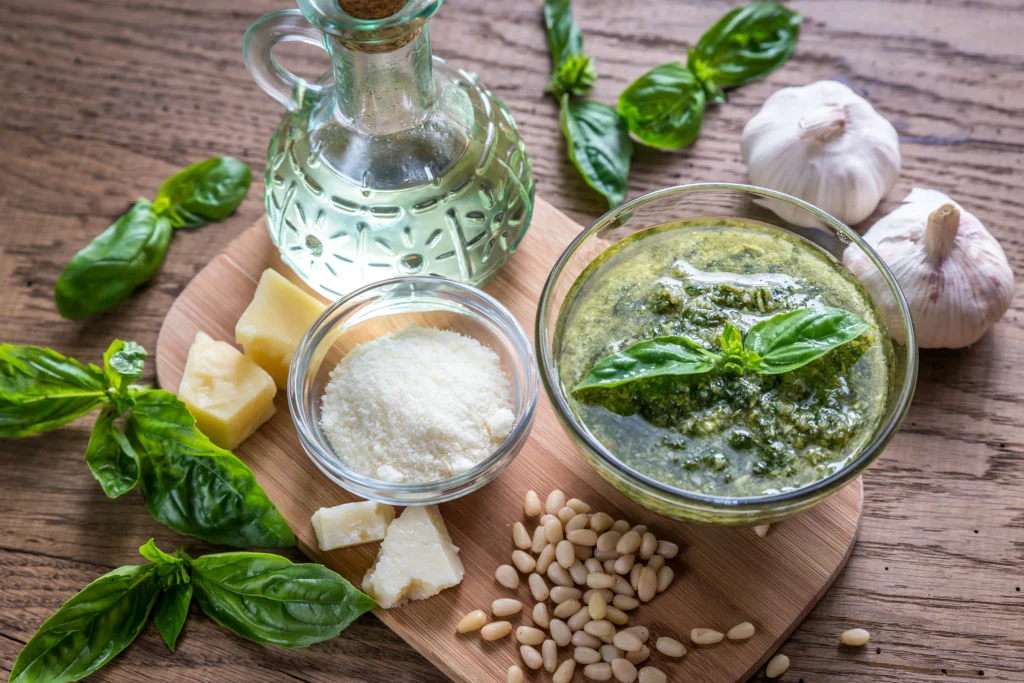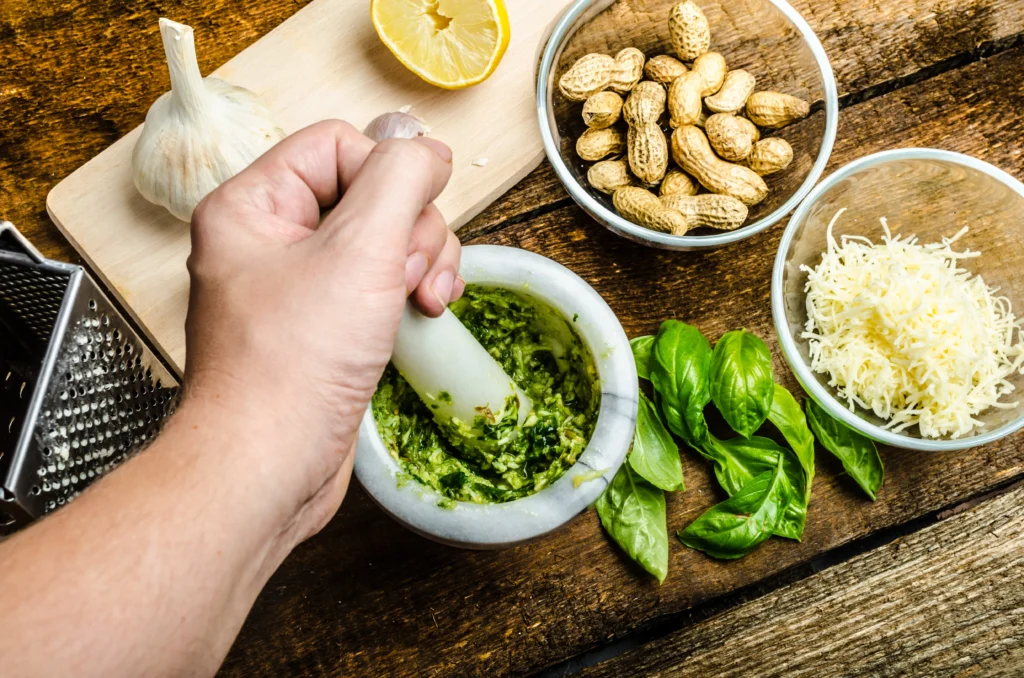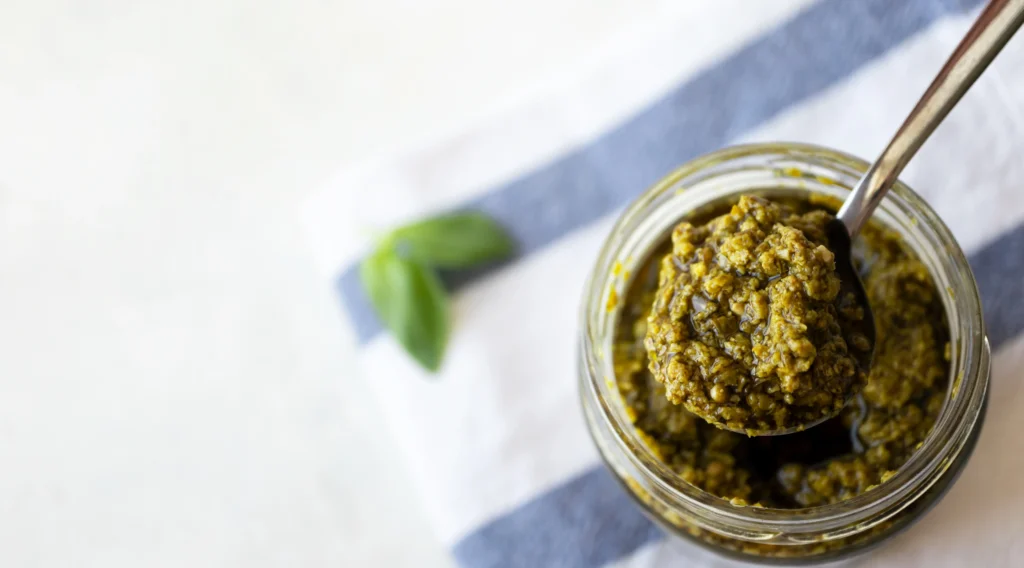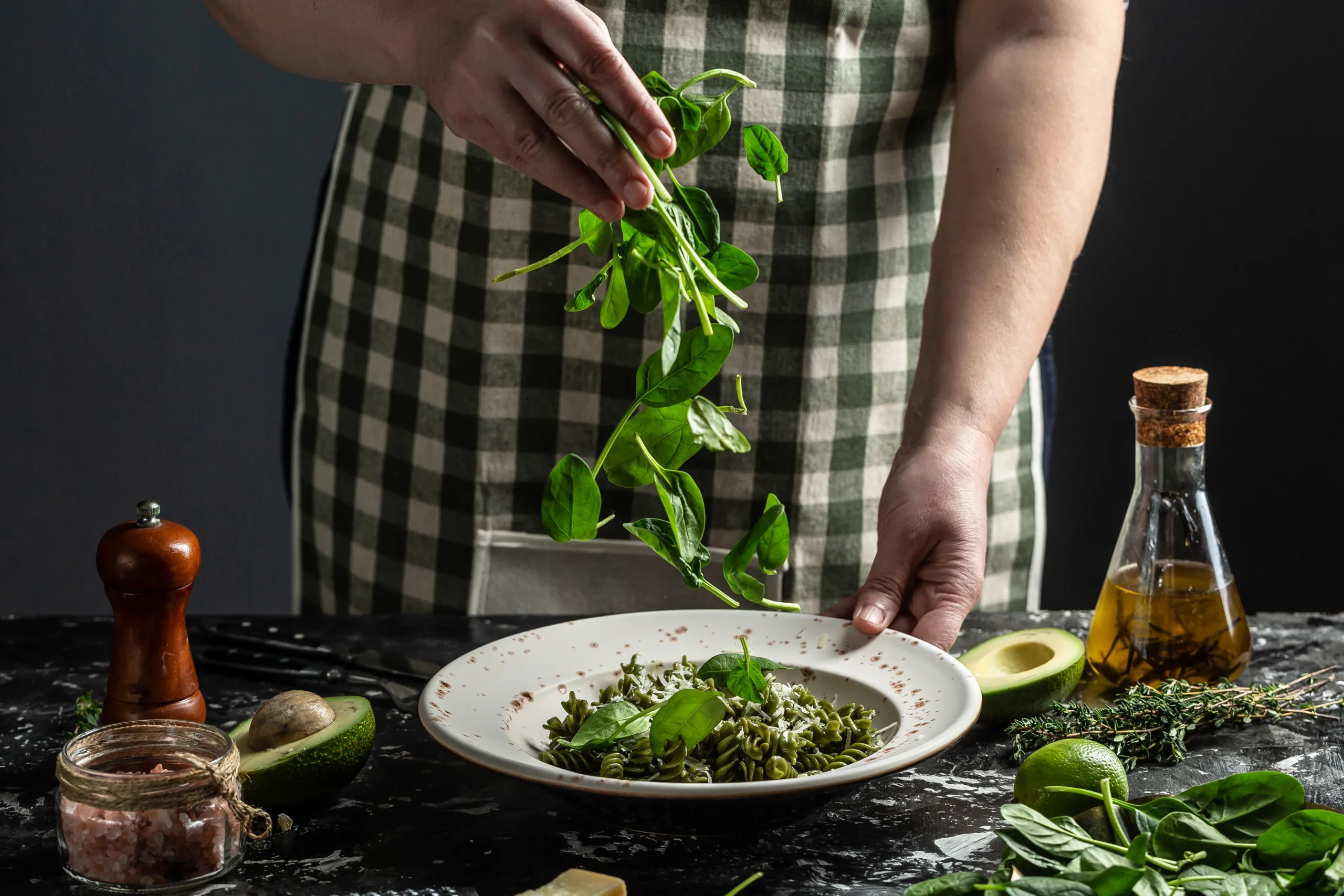Pesto is a beloved Italian sauce, known for its vibrant green color, aromatic fragrance, and rich, fresh flavors. Traditional pesto is a beautiful blend of fresh basil, olive oil, garlic, Parmesan cheese, and pine nuts, typically served with pasta, but also used as a spread, dip, or topping for various dishes. However, pine nuts can be expensive, and some people may have allergies or simply prefer not to use them. This pesto recipe without pine nuts proves that you can still create a pesto that’s just as creamy, rich, and delicious as the classic, without sacrificing flavor.
In this article, we will show you how to make pesto without pine nuts, and we’ll explore how simple substitutions like sunflower seeds or walnuts can transform your pesto into something that tastes just as amazing as the original.
Let’s dive into the details!

Why Make Pesto Without Pine Nuts?
Pine nuts, though a key ingredient in traditional pesto, are often expensive and not always easy to find. Not only that, they can also pose a challenge for people with nut allergies. For those reasons, many people turn to alternative ingredients, such as sunflower seeds, walnuts, or cashews, to replace pine nuts while maintaining the texture and flavor of the original pesto.
Additionally, pine nuts are not always the most affordable ingredient, especially for those making large batches of pesto or who are looking for a budget-friendly option. Thankfully, there are plenty of substitutes that work beautifully and provide their own nutritional benefits, such as the inclusion of omega-3 fatty acids, antioxidants, and healthy fats.
Creating a pesto without pine nuts doesn’t have to mean compromising on flavor. On the contrary, using a variety of different seeds or nuts can create a unique twist on the classic, offering both delicious taste and convenience.

Ingredients for Pesto Without Pine Nuts
To make a pesto that tastes just like the classic but without pine nuts, here’s what you’ll need:
- 2 cups fresh basil leaves – Basil is the backbone of any pesto, giving it that fresh, herby flavor.
- 1/2 cup Parmesan cheese – This adds a deep, savory richness to the pesto, complementing the freshness of the basil.
- 2 cloves garlic – The garlic provides the necessary kick that balances out the richness of the cheese and olive oil.
- 1/2 cup extra virgin olive oil – This smooths out the texture of the pesto and adds a fruity, rich flavor.
- 1/4 cup sunflower seeds (or your preferred substitute) – Sunflower seeds are an excellent alternative to pine nuts, bringing a mild, nutty flavor and a bit of crunch.
- Salt, to taste – Salt brings out the best in the ingredients, making them more vibrant.
- 1 tablespoon lemon juice (optional) – A touch of lemon juice brightens the flavor, giving your pesto a fresh zing.
- Freshly ground black pepper (optional) – For added seasoning, a pinch of black pepper can elevate the flavors.
These ingredients are all you need to create a delicious, nut-free pesto that maintains the balance of flavors the original recipe is known for.

Step-by-Step Instructions to Make Pesto Without Pine Nuts
Making pesto without pine nuts is easier than you might think! It only takes a few simple steps, and you’ll be enjoying this flavorful sauce in no time.
Step 1: Prepare Your Ingredients
First, wash your basil leaves thoroughly to remove any dirt or pesticides. Dry them gently using a kitchen towel or paper towel to avoid excess moisture. Peel the garlic cloves and measure out the rest of your ingredients.
If you’re using sunflower seeds or any other alternative nuts or seeds, lightly toast them in a dry pan over medium heat for 3-4 minutes. This helps bring out their natural flavor and adds an extra layer of depth to the pesto.
Step 2: Blend the Ingredients
In a food processor or high-powered blender, combine the basil leaves, Parmesan cheese, garlic, and sunflower seeds (or other substitute). Pulse the mixture several times until the ingredients are finely chopped and incorporated.
Step 3: Add the Olive Oil
With the food processor running, slowly add the olive oil in a steady stream. Continue processing until the pesto reaches your desired consistency. You can make it smoother or chunkier, depending on your preference. If the pesto is too thick, you can add more olive oil, a little at a time, or even a splash of water to loosen it up.
Step 4: Season to Taste
Once your pesto is well-blended, taste it and adjust the seasoning as needed. Add salt to taste and a squeeze of fresh lemon juice if you prefer a slightly tangy flavor. You can also add a pinch of freshly ground black pepper for added depth.
Step 5: Store and Serve
Transfer your pesto to an airtight container or jar, and store it in the refrigerator. The pesto can be kept fresh for up to a week, and it’s even freezer-friendly for longer storage.

Tips for the Perfect Pesto Without Pine Nuts
While making pesto without pine nuts is straightforward, there are a few tips and tricks that can help you create the best version possible:
- Use High-Quality Olive Oil: Olive oil plays a major role in the flavor of pesto, so make sure to use extra virgin olive oil for the best results. A high-quality olive oil will lend a fruity and peppery taste to your pesto, which is essential for its flavor profile.
- Experiment with Nuts and Seeds: While sunflower seeds are a great substitute, don’t hesitate to experiment with other nuts or seeds, like walnuts, cashews, or even pumpkin seeds. Each alternative brings its own unique flavor to the table.
- Toast Your Nuts or Seeds: Toasting your nuts or seeds before blending them into the pesto can enhance their flavor, making the pesto even richer and more aromatic.
- Balance the Texture: Pesto can be made to your preferred texture. If you like a smooth pesto, blend it longer. If you prefer it chunkier, pulse the mixture less. You can also adjust the consistency by adding more olive oil, a little at a time.
- Add Fresh Herbs: Although basil is the star ingredient in pesto, feel free to experiment by adding other fresh herbs, such as parsley, arugula, or spinach. These herbs can enhance the flavor profile, making it even more vibrant.
Creative Ways to Use Pesto Without Pine Nuts
Once your pesto is ready, there are plenty of delicious ways to incorporate it into your meals. Here are a few creative uses for your homemade pesto:
1. Pasta – Toss with your favorite pasta for a quick and flavorful dish. Pesto goes wonderfully with spaghetti, penne, fusilli, or any pasta of your choice.
2. Sandwiches & Wraps – Spread pesto on sandwiches, wraps, or even burgers for an added burst of flavor. It pairs wonderfully with fresh veggies and grilled chicken.
3. Grilled Vegetables – Drizzle pesto over grilled or roasted vegetables like zucchini, eggplant, and bell peppers. It adds a fresh, herbaceous finish to any veggie dish.
4. Pizza – Use pesto as a base for pizza instead of traditional tomato sauce. It adds a flavorful twist to your favorite pizza combinations.
5. Dips and Spreads – Serve pesto as a dip with fresh bread, crackers, or raw veggies. It’s a great appetizer for gatherings.
6. Soup – Stir pesto into soups for a creamy texture and rich flavor. It works particularly well in vegetable, chicken, or tomato-based soups.
7. Egg Dishes – Add pesto to scrambled eggs or omelets for a burst of flavor. It also pairs perfectly with poached or fried eggs.
Conclusion
Pesto without pine nuts is just as flavorful and satisfying as the classic recipe, and it’s the perfect option for anyone with nut allergies, a tight budget, or simply looking for a healthier alternative. With just a few simple ingredient swaps, you can create a pesto that’s creamy, rich, and full of flavor. Whether you’re tossing it with pasta, spreading it on a sandwich, or using it as a dip, this pesto recipe will quickly become one of your favorites.
So, give this pine nut-free pesto a try, and enjoy the deliciousness that is pesto without compromise!
Table of Contents
https://labelrecipes.com/sizzle-serve-blackstone-fried-rice-recipe-step/
https://www.feastforafraction.com/homemade-pesto-without-pine-nuts/

